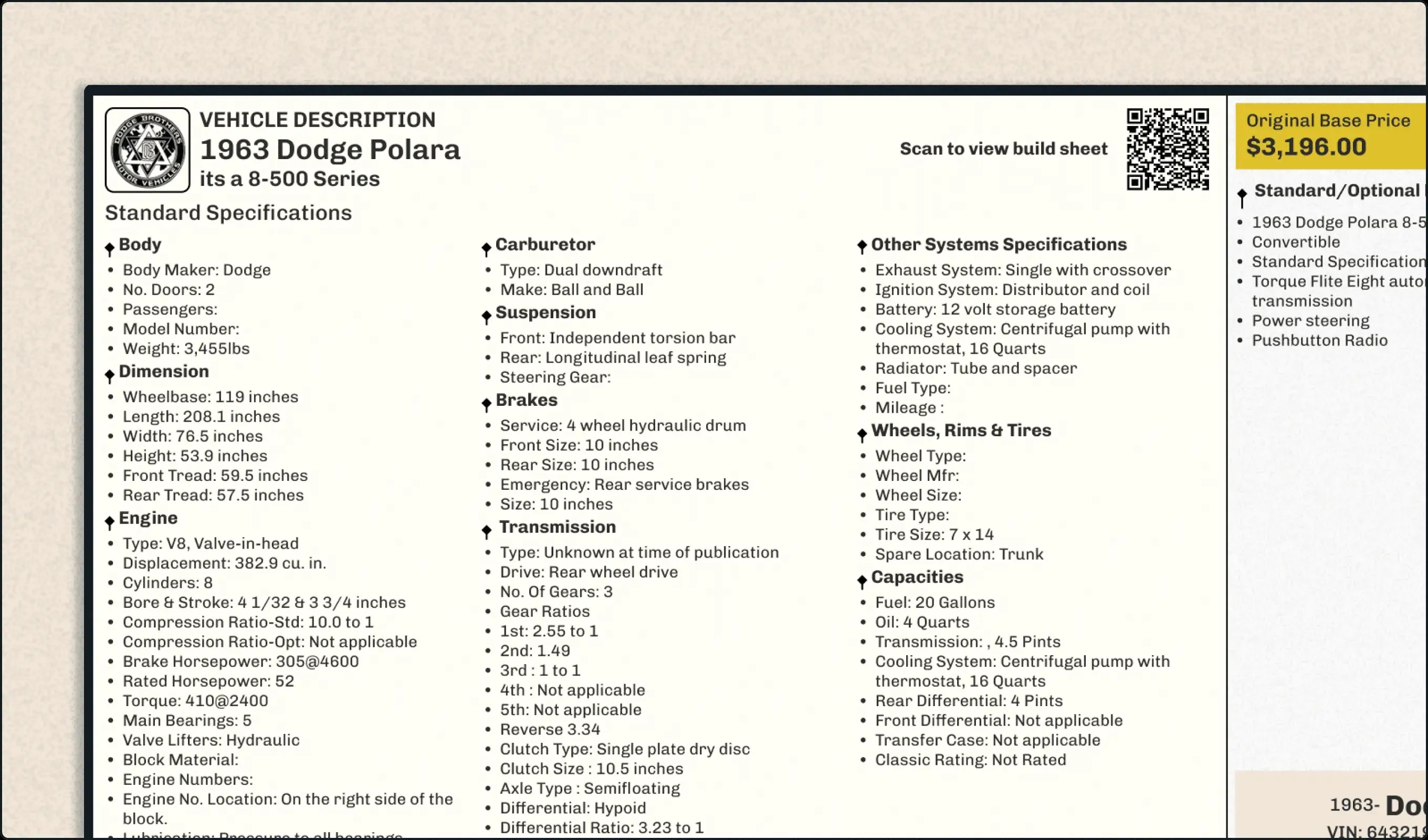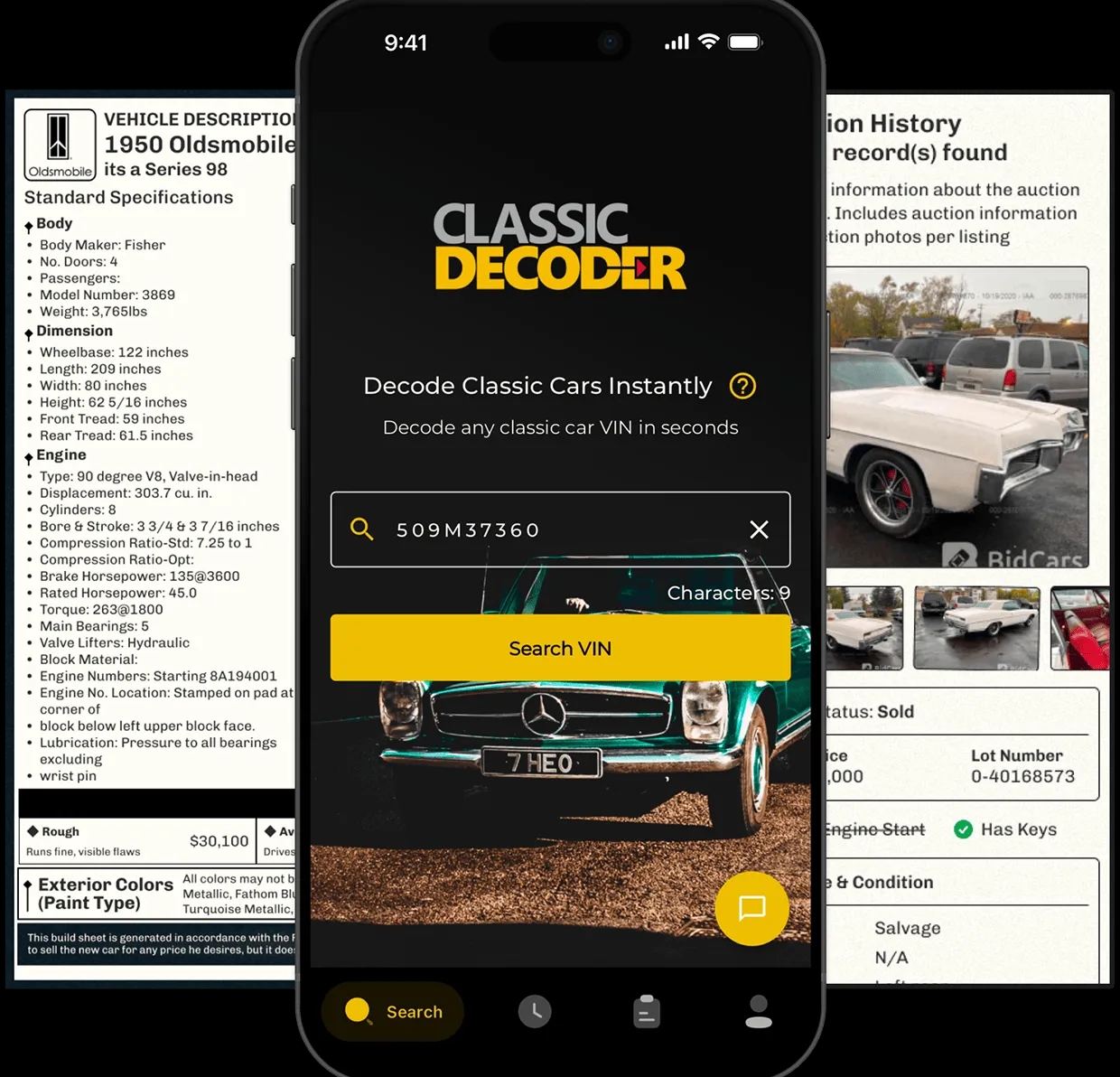1953 Studebaker Commander
The '53 Studebaker Commander? A seriously cool classic! Its unique, futuristic design, a departure from the norm, made it a head-turner. It reflects a post-war optimism and embodies a distinct moment in automotive history. Think sleek lines and that iconic, almost space-age grille—a real beauty!
Decode Classic VINs to Get Vehicle History Report and Build Sheet
1953 Studebaker Commander: A Classic Car Legend
The 1953 Studebaker Commander is not just another classic car; it's a blend of elegance, innovation, and cultural significance wrapped in a stylish four-wheeler. This iconic model is renowned for its unique Bullet-Nose design and its impact in the post-World War II automotive market. Boasting a performance-driven V8 engine and sleek aesthetics, the Commander became more than just a vehicle; it was a symbol of the era's optimism and technological progress.

1953 Studebaker Commander Models:
Select the vehicle's model to see the correct data for it.
How Much is Studebaker Commander Worth?
Original MSRP :$2,001.00
Outstanding
Clean
Average
Rough
1953 Studebaker Commander Specs
Interested in buying a classic car or selling one?
Access detailed history reports for classic vehicles from hundreds of manufacturers.
- Accident Records
- Theft Records
- Loan & Lien Information
- Auction Information
- Salvage Information and more

History of the 1953 Studebaker Commander
The Studebaker Commander, like a fine wine, matured gracefully with time. Originally launched as part of Studebaker's efforts to rejuvenate its brand image, the 1953 model captivated consumers with its Raymond Loewy-inspired design. This model came in various body styles, including a two-door hardtop and a four-door sedan, making it versatile and appealing.
Despite its strengths, Studebaker faced financial challenges in the mid-1960s. However, the legacy of models like the 1953 Commander continued to resonate with enthusiasts, ensuring its place in American automotive lore.
Learn more about a classic car: Get Build Sheet by VIN.
Access reproduced classic build sheets to learn more about your classic vehicle details.
- Standard Specifications
- Original Base Price
- Standard & Optional Equipment
- Exterior & Interior Colors
- VIN ID & Location description

Detailed Specifications
The Commander boasted a robust V8 engine, offering a 0-60 mph acceleration time of just 17.9 seconds. It wasn't the fastest car around, but it was reliable and economical, with a fuel efficiency of 26.1 miles per gallon at 30 mph—a figure that didn't go unnoticed during endurance runs.
Popular Figures Who Own the 1953 Studebaker Commander
While the Commander didn't pass through the hands of every celebrity, it did find its way into notable garages, further boosting its allure.
Paul and Betty Gilliam
Paul and Betty Gilliam cherished their beautifully crafted 1953 Commander. Their ownership spotlighted the car as an icon of classic automotive beauty and design.
1953 Studebaker Commander Gallery














Cultural References and Pop Icon Status
The Commander has starred in numerous films and TV shows, reflecting its pivotal role as a cultural icon. From appearing in iconic films to being seen in parades, this model captured the essence of 1950s Americana. Its place in music, featured in songs that celebrated the open road experience, only solidified its status.
Fun Facts about the 1953 Studebaker Commander
Originally mid-priced, its value has significantly increased, with well-maintained models fetching anywhere from $20,000 to over $100,000 today.
The Commander's Bullet-Nose design remains one of its most celebrated features, cementing its reputation in the automotive world.
Interested in Buying or Selling a Classic Car?
Whether you're buying or selling, understanding a vehicle's history is crucial. A proper vehicle history report and can provide invaluable insights:
Accident Records
Theft Records
Loan & Lien Information
Auction Information
Salvage Information and more
Explore services to ensure you're making informed decisions.
Remember, determining the car's unique VIN number, like or , helps in confirming many details about your classic's originality and past stories.
This intriguing piece of automotive history, the 1953 Studebaker Commander, is more than a car; it's a journey through time, reflecting a pivotal era of cultural change and innovation.
Classic VIN Decoder App |Now available on both Android and iOS!
At Classic Decoder, we believe that developing a mobile app is a great way to extend our classic car data solution hub to as many users as possible across the globe. Our app is built with users and precision in mind. It holds the key to unlocking the history and details of any retro car at your fingertips. It also comes with fascinating and user-friendly features that make it stand out from other mobile apps designed for this purpose.
The Classic Decoder app lets you decode and lookup any classic VIN in a flash. Access accurate vehicle information and history, make an informed decision faster, and buy and trade in classic cars with confidence.

Download The Classic Decoder App now.
Some unique features include:
- Support all classic VIN lengths from 5 to 13 digits
- Support classic cars produced from 1910 – 1980
- Online Garage features – to add and manage your vehicles
- 24/7 Customer Support
- Easy onboarding for first-time users
Explore The Most Popular Classic Cars
Frequently Asked Questions
Well, the '53 Commander, it's a real looker, isn't it? You'll instantly recognize its distinctive styling; that low, sleek profile is pretty unforgettable. The wraparound windshield is a dead giveaway, and those iconic chrome accents? Pure 50s style. It's got this kinda bullet-nosed hood, too—pretty sharp. But beyond the looks, it's also known for its innovative features for the time, like its independent front suspension, which made for a surprisingly smooth ride. Think of it like the difference between riding a horse and a fancy Cadillac; huge improvement! Of course, there were different trim levels so it's not always immediately apparent you're seeing a Commander, but those basics generally apply.
The 1953 Commander typically came with a 232 cubic inch V8, a pretty stout engine for its time. It wasn't the most powerful thing on the road, mind you, but it was more than adequate for most folks. Think of it as that reliable old workhorse that could get you where you need to go without too much fuss. Some models also came with a smaller six-cylinder engine; kinda less common, though, so don't expect to see that one too often, unless you're really looking in the right places. Those six-cylinder models are rare as hens' teeth. You'd be super lucky to find one in pristine condition!
Compared to modern cars, it's slower, of course; this isn't a sports car, no way! But that doesn't mean it's a slug. For its day, it was a reasonably peppy car; you’ll find it pretty responsive, if you treat it right. Acceleration wasn’t exactly breakneck, and highway cruising speed would be different than you're used to; maybe think of a comfortable 55-60mph as its happy place. Remember, it’s more about the experience than sheer speed; it's about getting the feel of classic American car culture. It’s like comparing a vintage record player to your Spotify playlist—different, but each with its charm.
Like any classic car, you'll need to expect some maintenance. Stuff like electrical gremlins (they love to hide in old cars, those pesky things!), carburetor issues, and brake system quirks are all things to anticipate. Basically, it's best to find a well-maintained example. You'll need to find a mechanic familiar with these models; it's not always easy. Getting parts can be a bit of a challenge too, but hey, that's part of the charm, the hunt, you know? Think of it as a treasure hunt, each part a hard-won prize, a small victory in your quest for automotive history. But if you’re careful, a Commander can be a supremely reliable driver, in spite of those issues.
Oh boy, that's tough to say. The value really depends on the condition, how original the car is, and how much of that lovely chrome is left! A fully restored beauty? That's going to fetch a pretty penny. A project car that needs some serious TLC? Well, you’re looking at a much lower price. So yeah, it's quite variable, you need to do your research on collector car sites. Just remember, things can change quick in that market. It’s like the stock market, except instead of stocks, it’s cool classic cars! You can find price guides, but those are really just estimates.

